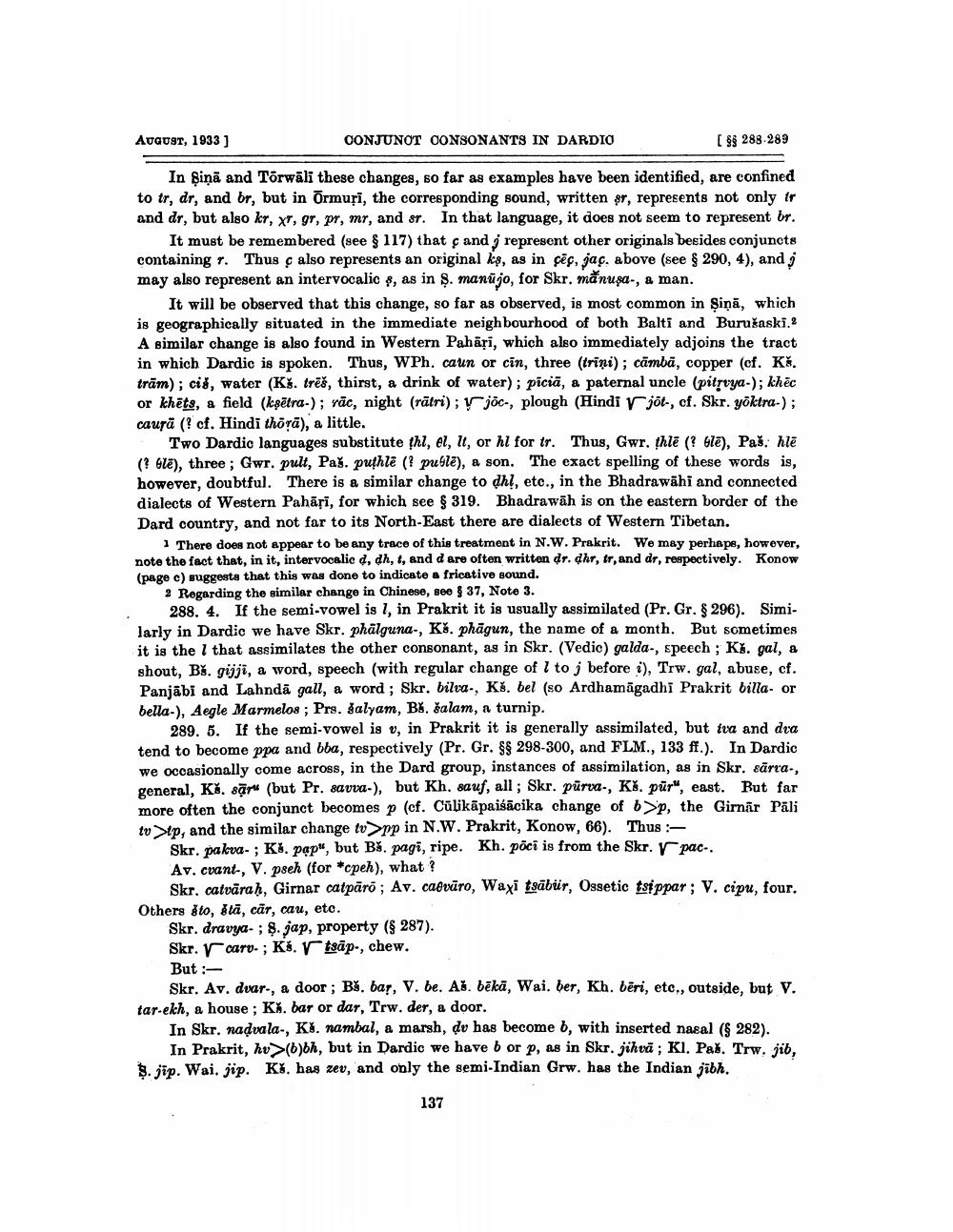________________
AUGUST, 1933)
CONJUNOT CONSONANTS IN DARDIO
( 88 288 289
In Sinā and Torwāli these changes, so far as examples have been identified, are confined to tr, dr, and br, but in Ormuri, the corresponding sound, written $T, represents not only ir and dr, but also kr, xr, gr, pr, mr, and sr. In that language, it does not seem to represent br.
It must be remembered (see $ 117) that cand represent other originals besides conjuncts containing 1. Thus c also represents an original kş, as in çēc, jac. above (see $ 290, 4), and i may also represent an intervocalic &, as in . manūjo, for Skr. mănuşa., a man.
It will be observed that this change, so far as observed, is most common in Siņā, which is geographically situated in the immediate neighbourhood of both Balti and Burušaski. A similar change is also found in Western Pahāri, which also immediately adjoins the tract in which Dardic is spoken. Thus, WPh. caun or cīn, three (trini); câmbă, copper (cf. K. trām); cis, water (Kš. trēš, thirst, a drink of water); picia, a paternal uncle (pitsvya-); khēc or khēts, a field (ksētra-) ; rāc, night (rātri); Vjoc, plough (Hindir jöt-, cf. Skr. yoktra-) ; causā (? cf. Hindi thörā), a little.
Two Dardic languages substitute thi, el, lt, or hl for tr. Thus, Gwr. thlē (? 612), Paš. hle (? 412), three; Gwr. pult, Paš. puthia (1 puslē), a son. The exact spelling of these words is, however, doubtful. There is a similar change to dhl, etc., in the Bhadrawāhi and connected dialects of Western Pahāri, for which see $ 319. Bhadrawāh is on the eastern border of the Dard country, and not far to its North-East there are dialects of Western Tibetan.
1 There does not appear to be any trace of this treatment in N.W. Prakrit. We may perhape, however, note the fact that, in it, intervocalie d, dh, t, and d are often written dr. dhr, fr, and dr, respectively. Konow (page c) suggests that this was done to indicate a fricative sound.
Regarding the similar change in Chinese, seo $ 37, Note 3.
288. 4. If the semi-vowel is 1, in Prakrit it is usually assimilated (Pr. Gr. 8 296). Similarly in Dardic we have Skr. phälguna-, Kš. phāgun, the name of a month. But sometimes it is the l that assimilates the other consonant, as in Skr. (Vedio) galda-, speech ; Kš. gal, a shout, Bš. gijji, a word, speech (with regular change of I to j before i), Trw.gal, abuse, cf. Panjābi and Lahndā gall, a word ; Skr. bilva-, Kš. bel (so Ardhamāgadhi Prakrit billa- or bella-), Aegle Marmelos ; Prs. galyam, BX, čalam, a turnip.
289. 5. If the semi-vowel is v, in Prakrit it is generally assimilated, but fra and dra tend to become ppa and bba, respectively (Pr. Gr. &S 298-300, and FLM., 133 ff.). In Dardic we occasionally come across, in the Dard group, instances of assimilation, as in Skr. sārra., general, Kš. samu (but Pr, savva-), but Kh. sauf, all; Skr. pūrva., K. pūr", east. But far more often the conjunct becomes p (cf. Cülikāpaisācika change of b p, the Girnar Pali tv tp, and the similar change tv >mp in N.W. Prakrit, Konow, 66). Thus -
Skr. pakva- ; K. pap, but Bš. pagi, ripe. Kh. põci is from the Skr. r pac-. Av. cvant-, V. pseh (for *cpeh), what?
Skr. catvārah, Girnar catpāro; Av. cavūro, Waxi tsābur, Ossetic tsippar; V. cipu, four. Others Sto, stā, car, cau, etc.
Skr. dravya- ; $. jap, property ($ 287). Skr. r carv. ; Kš. rtsāp., chew. But
Skr. Av. dvar., a door; Bš, bar, V. be. Aš. bēkā, Wai. ber, Kh. bēri, etc., outside, but V. tar-ekh, a house ; K.. bar or dar, Trw. der, a door.
In Skr, nadvala-, K. nambal, a marsh, du has become b, with inserted nasal (& 282).
In Prakrit, hv>(6)bh, but in Dardic we have b or P, as in Skr. jihvā; KI. Paš. Trw. jib, $. lip. Wai. jip. K%, has zev, and only the semi-Indian Grw. has the Indian jibh.
137




